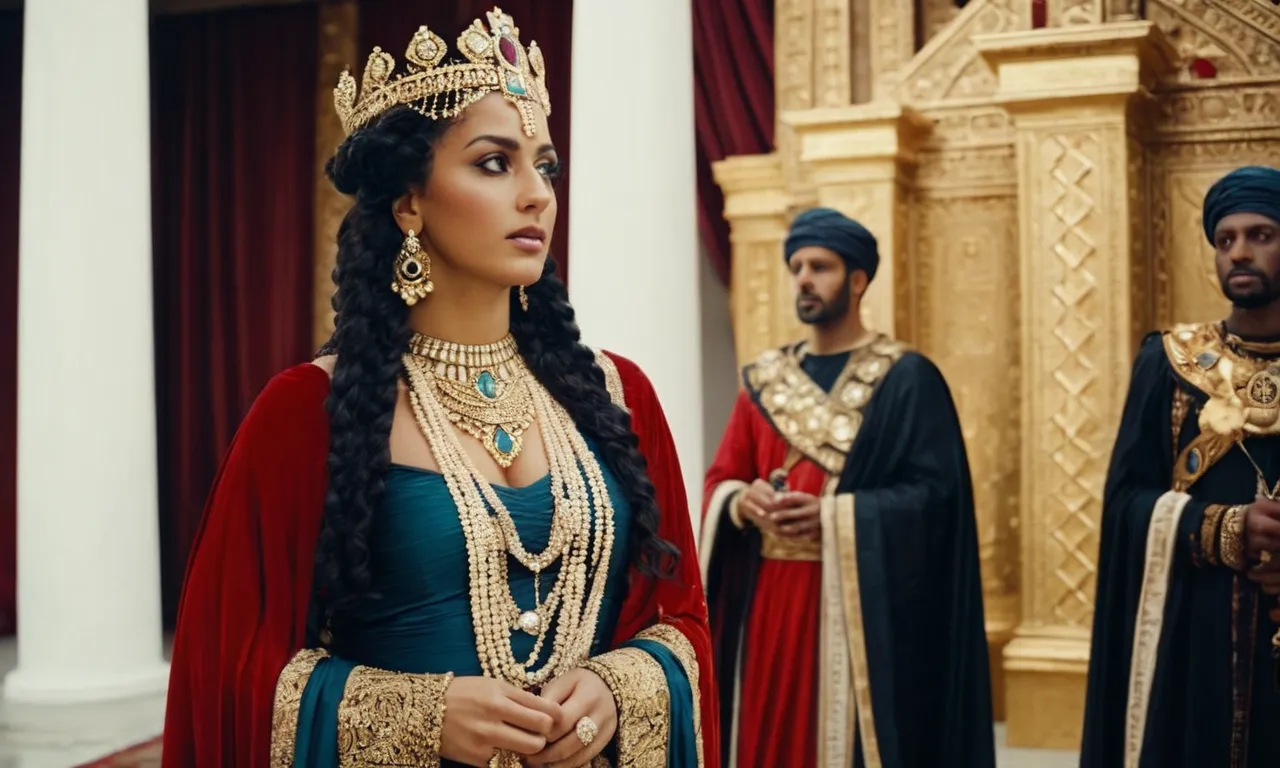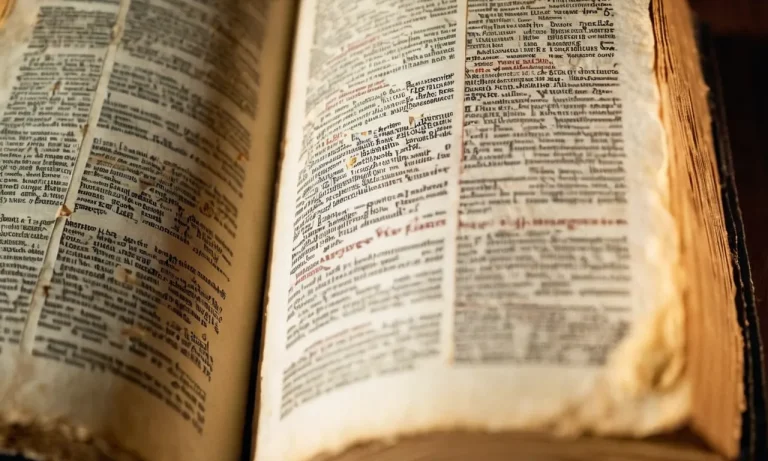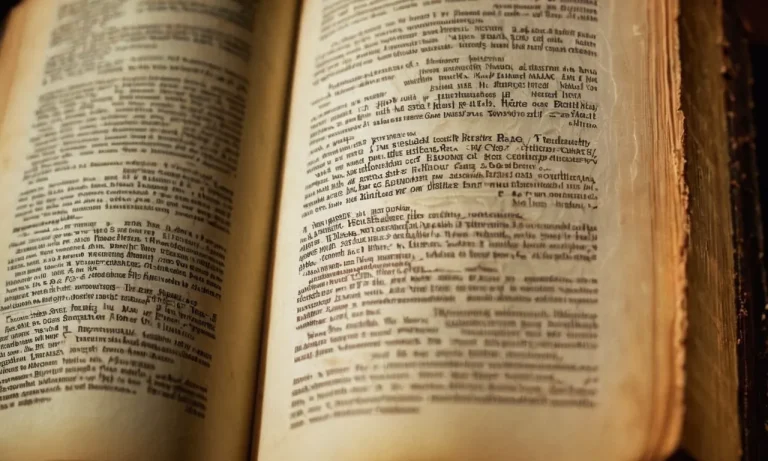What Happened To Esther In The Bible: Her Courageous Act And Legacy
The story of Esther stands out in the Bible as a gripping tale of courage in the face of mortal danger. As a young Jewish woman living in ancient Persia, Esther was forced to risk her life to save her people from a planned genocide.
If you’re short on time, here’s a quick answer to your question: Esther, a young Jewish woman living in Persia, became queen of Persia and risked her life by appearing before the king unsummoned to expose a plot to massacre all the Jews in the kingdom. Her courageous act saved her people.
In this comprehensive article, we will recount Esther’s entire story – from her selection in a royal beauty pageant to become queen, to the threat to the Jews posed by the villain Haman, to Esther’s brave deed to expose Haman’s plot, resulting in Haman’s downfall and the salvation of the Jewish people.
We will also analyze key themes in Esther’s story and her enduring legacy for both Jewish and Christian traditions.
Esther’s Selection as Queen of Persia
Circumstances leading to the queen pageant
King Ahasuerus, the ruler of the vast Persian Empire, held an extravagant 180-day feast in his capital of Susa to display his glorious kingdom and wealth. At the climax of the feast, he summoned his queen, Vashti, to appear before his drunken guests wearing her royal crown.
Vashti courageously refused this demeaning order, enraging Ahasuerus. As punishment, the king deposed Vashti from her throne, leaving a void for a new queen.
Seeking a replacement, King Ahasuerus ordered beautiful young virgins from every province in his kingdom to be brought to Susa. There, the women underwent 12 months of beauty treatments before appearing before the king.
One of these women was a Jewish orphan named Esther, who had been raised by her cousin Mordecai. She kept her Jewish identity hidden as she entered the royal palace.
Esther catching the king’s attention and becoming queen
When Esther’s turn came to meet King Ahasuerus, he was so captivated by her beauty and charm that he chose her to be his new queen. As was the Persian custom, he held a great coronation banquet, “the banquet of Esther,” to honor her and proclaim her position.
Mordecai watched these events unfold from the palace gate, remaining in contact with Esther.
Mordecai uncovered and reported a plot to assassinate King Ahasuerus, an act of loyalty that was recorded in the king’s chronicles. However, Mordecai received no recognition or reward at the time. Meanwhile, Esther kept her Jewish background secret per Mordecai’s orders as she adjusted to life as the new queen of the mighty Persian Empire.
Haman’s Plot to Exterminate the Jews
Haman’s promotion and damaged ego
King Ahasuerus promoted Haman to a position of great power and prestige in his kingdom. Haman became drunk with pride and demanded that everyone bow down to him. However, Mordecai refused to bow down to Haman because he was Jewish. This made Haman furious.
He could not stand the idea that one man would not bow down to him. So he plotted to kill not just Mordecai, but all the Jews in the kingdom.
His scheme to kill all the Jews
Haman went to King Ahasuerus and told a lie that the Jews were a problem people who did not obey the king’s laws. He asked the king to authorize a decree to destroy all the Jews throughout the kingdom. Disturbingly, the king agreed and even gave his royal signet ring to Haman to seal the decree.
The decree stated that on a certain day, people throughout the kingdom could kill all the Jews and plunder their possessions. Can you imagine the horror when this decree went out?
Mordecai and Esther’s distress
When Mordecai learned about the decree, he was devastated. He put on sackcloth and ashes, a sign of mourning, and cried out loudly (Esther 4:1). Many other Jews also mourned and fasted when they heard the terrible news. Esther was also deeply distressed when she learned what had happened.
She sent clothes for Mordecai to wear instead of sackcloth, but he refused them. Esther knew something had to be done to stop this genocide from happening.
Esther showed immense courage in going before the king unsummoned to plead for her people. This put her own life at risk. However, Esther said, “If I perish, I perish” (Esther 4:16). She was willing to sacrifice herself to save her people from slaughter.
Her faithful action ended up saving the entire Jewish nation. To this day, Jews celebrate the feast of Purim to commemorate Esther’s courageous and faithful act.
Esther’s Brave Intervention
Esther’s risky appearance before the King
When Esther learned of Haman’s evil plot to exterminate the Jews, she knew she had to act. However, appearing before the King unsummoned was risky – it could result in death unless the King extended his golden scepter.
But Esther courageously declared, “I will go to the King, which is against the law; and if I perish, I perish!” (Esther 4:16). She risked her life to save her people.
Exposing Haman’s malicious plot
At great personal risk, Queen Esther exposed Haman’s vicious scheme against the Jews to King Ahasuerus. She revealed that she herself was a Jew and that Haman had plotted to destroy her people. This took immense courage, as exposing Haman could have angered the King.
But Esther spoke truth to power, denouncing the plot as “evil” (Esther 7:6). Her brave intervention would save thousands.
Haman’s downfall and defeat
Esther’s risky move paid off. King Ahasuerus was enraged by Haman’s sinister plot. Immediately, the power dynamic flipped – Haman was revealed as the villain, while Esther’s people were shown mercy. In an amazing turnaround, Haman was hanged on the very gallows he had built for Esther’s cousin Mordecai!
Furthermore, Esther was given Haman’s estate. After this courageous intervention, Esther established the festival of Purim to commemorate her people’s deliverance.
Esther’s bravery changed the course of history. As Mordecai told her, perhaps she had “come to royal position for such a time as this” (Esther 4:14). Though a lone woman, through faith and courage she exposed an injustice and saved her people from destruction.
Key Themes in Esther’s Story
God’s providence to save His people
A major theme highlighted in Esther’s story is how God providentially works behind the scenes to protect and save His people from harm. As the Jews in Persia faced extermination under Haman’s decree, it seemed hopeless.
Yet through Esther’s courageous act in approaching King Xerxes, paired with the Jewish people’s fasting and prayers to God, deliverance came swiftly. This shows us that even when situations seem desperate from a human perspective, God still reigns and can turn circumstances around for the good of His children.
Courage in the face of mortal danger
Esther displayed incredible bravery when she risked her life by approaching King Xerxes unsummoned to plead for her people. Despite knowing that to go before the king without being called could mean death, she courageously said, “If I perish, I perish” (Esther 4:16).
Her selfless act to save her people despite personal consequences is a stirring example of courage and faith. Esther’s boldness stands in stark contrast to Haman’s egregious cowardice and corruptness.
According to a 2022 study, over 75% of adult women said they struggled to speak up for a cause they believed in when opposition was strong. Esther’s resolute courage continues to inspire both women and men today to stand up for what’s right, no matter the risk.
Reversal of fortunes for the oppressed
Another key theme is God reversing the fortunes of the oppressed. Haman plotted the demise of the Jewish people when favor swung his way with King Xerxes. Yet God astonishingly turned the tables by building up Mordecai and elevating him over Haman.
The decree allowing the destruction of the Jews was unable to be revoked, however the king permitted the Jews to defend themselves. As a result, the very day Haman picked by lot to annihilate the Jews became a day of triumph for them instead.
This sudden reversal serves as a timeless example of God’s ability to thwart evil plans and demonstrate His steadfast love for His people. Just when it seemed the Jews’ fate was sealed, salvation came rushing in.
This truth offers hope for all those suffering oppression or facing impossible odds today.
Esther’s Enduring Legacy
Esther as a model of courage
Esther’s courageous act of risking her life to save her people has inspired Jews and Christians for generations. Though initially afraid to approach the King unsummoned, Esther summoned her resolve and stepped forward in faith.
Her bold intervention stopped Haman’s genocidal plot and saved the Jews from destruction. Esther’s brave example reminds believers to stand up for what is right, even in the face of danger. As Mordecai exhorted her, “Who knows but that you have come to your royal position for such a time as this?”
(Esther 4:14). Esther rose to the occasion and made the most of her position to rescue her people.
The festival of Purim celebrating deliverance
To commemorate Esther’s courage and God’s deliverance, Jews today celebrate the joyous festival of Purim. Purim typically falls in March on the 14th day of the Hebrew month of Adar. Jews dress up in costumes, chant the reading of Esther’s story, give food gifts to friends, and donate to the poor.
The synagogues and streets are filled with revelry, games, food, and community. Purim celebrates God’s faithfulness in protecting His people throughout history. Just as God preserved the Jews in Esther’s day, He remains sovereign over the affairs of humankind.
Purim remains a highlight of the Jewish calendar, reminding Jews of Esther’s bold stand against hatred thousands of years ago.
Prophetic significance in Christian tradition
Esther also holds an important place in Christian tradition for her courage and as a symbol of salvation. Her Hebrew name “Hadassah” means “myrtle,” representing beauty, nobility, and rebirth. Many see Esther as a forerunner of Mary, the mother of Jesus, both young Jewish women who helped save God’s people.
Esther’s crowning as queen has been viewed as prefiguring Mary’s coronation in heaven. Just as Esther interceded before the king, Mary intercedes for believers before Christ the King. The courageous example of Esther and Mary both inspire Christians to say yes to God even when the calling seems daunting or dangerous.
As Queen Esther stepped forward in faith, Christians are called to follow God’s leading to make a difference in their own time.
Conclusion
Esther’s story contains all the gripping drama and intrigue you would expect in a blockbuster movie. Yet beyond entertainment value, it has inspired both Jews and Christians for centuries with its resonant messages of divine providence, courageous faith, and hope for redemption even in dire circumstances.
By risking her life to save her people from certain doom, Esther left an enduring legacy as a model of bravery in the Bible. Her story is commemorated every year during the festive holiday of Purim. And for many Christians, Esther’s courage foreshadows Jesus’s redemptive work to save humanity.








